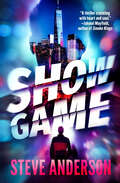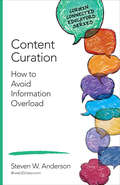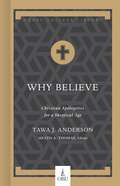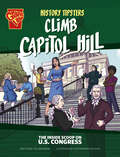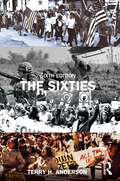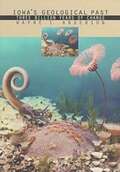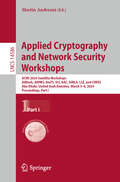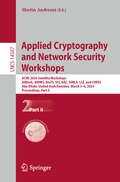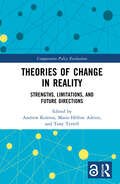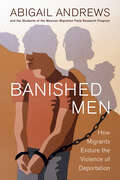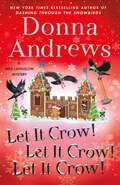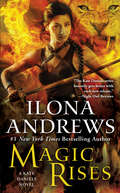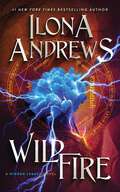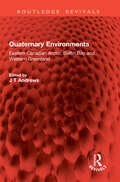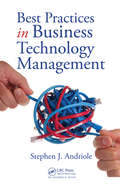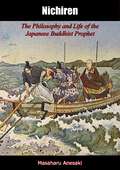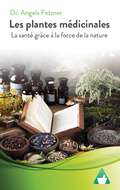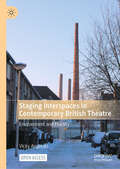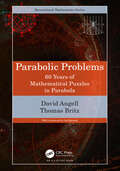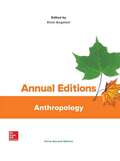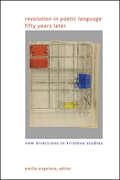- Table View
- List View
Show Game
by Steve AndersonA mysterious vigilante abducts powerful abusers and exposes them in a twisted &“Show Game,&” in this psychological thriller by the author of The Preserve. The pandemic may be over, but the world is not safe for those who prey on the innocent. A vigilante known by the alias &“Alex&” knows what these transgressors have done. And taking them captive is only the first step toward vengeance. In order to be set free, they must first play the Show Game . . . A predatory priest, a double-dealing politician, a fraudulent philanthropist—Alex has ways of making them confess, on camera, for all the world to witness. But the Show Game is building toward a darkly personal finale: exposing society&’s most notorious and evil abuser. As Alex gets closer to the main event, investigative reporter Owen Tanaka is determined to unmask the vigilante&’s true identity and motive. But when a shocking revelation hits close to home, Owen must decide whether to stop a criminal mastermind&’s devious scheme . . . or let the Show Game play its final round.
Content Curation: How to Avoid Information Overload (Corwin Connected Educators Series)
by Steven W. AndersonSavvy internet consumption starts right here! Teachers and students are constantly inundated with information, yet lack the organizational skill necessary to effectively utilize it. From Twitter hashtags to online communities, this handy guide will help you to find, store, and share the best information and resources found on the web today—and teach your students to do the same. Real-world tips, tools, in-depth examples and lesson plans help you systematically: Understand the curation process Find, collect, and share reliable web-based information Build students’ information literacy skills Help students research and organize problem-based learning projects Use cutting-edge curation tools like Evernote, Diigo, and Pocket The Corwin Connected Educators series is your key to unlocking the greatest resource available to all educators: other educators. Being a Connected Educator is more than a set of actions: it’s a belief in the potential of technology to fuel lifelong learning. "Speaking from his own experience and perspectives as a learner, teacher, and educational leader, Steven Anderson brings clarity to a process that can be difficult and overwhelming. Steven offers tried and tested strategies and tools for evaluating, organizing, and sharing the vast amount of online content educators and students have at their fingertips. If you′re drowning in digital content, this book is your life jacket. " —Jayme Linton, Assistant Professor of Education Lenoir-Rhyne University, Hickory, NC
Content Curation: How to Avoid Information Overload (Corwin Connected Educators Series)
by Steven W. AndersonSavvy internet consumption starts right here! Teachers and students are constantly inundated with information, yet lack the organizational skill necessary to effectively utilize it. From Twitter hashtags to online communities, this handy guide will help you to find, store, and share the best information and resources found on the web today—and teach your students to do the same. Real-world tips, tools, in-depth examples and lesson plans help you systematically: Understand the curation process Find, collect, and share reliable web-based information Build students’ information literacy skills Help students research and organize problem-based learning projects Use cutting-edge curation tools like Evernote, Diigo, and Pocket The Corwin Connected Educators series is your key to unlocking the greatest resource available to all educators: other educators. Being a Connected Educator is more than a set of actions: it’s a belief in the potential of technology to fuel lifelong learning. "Speaking from his own experience and perspectives as a learner, teacher, and educational leader, Steven Anderson brings clarity to a process that can be difficult and overwhelming. Steven offers tried and tested strategies and tools for evaluating, organizing, and sharing the vast amount of online content educators and students have at their fingertips. If you′re drowning in digital content, this book is your life jacket. " —Jayme Linton, Assistant Professor of Education Lenoir-Rhyne University, Hickory, NC
Pharmacopoeias, Drug Regulation, and Empires: Making Medicines Official in Britain’s Imperial World, 1618–1968 (Intoxicating Histories #10)
by Stuart AndersonThe word "pharmacopoeia" has come to have many meanings, although it is commonly understood to be a book describing approved compositions and standards for drugs. In 1813 the Royal College of Physicians of London considered a proposal to develop an imperial British pharmacopoeia – at a time when separate official pharmacopoeias existed for England, Scotland, and Ireland. A unified British pharmacopoeia was published in 1864, and by 1914 it was considered suitable for the whole Empire.Pharmacopoeias, Drug Regulation, and Empires traces the 350-year development of officially sanctioned pharmacopoeias across the British Empire, first from local to national pharmacopoeias, and later to a standardized pharmacopoeia that would apply throughout Britain’s imperial world. The evolution of British pharmacopoeias and the professionalization of medicine saw developments including a transition from Galenic principles to germ theory, and a shift from plant-based to chemical medicines. While other colonial powers in Europe usually imposed metropolitan pharmacopoeias across their colonies, Britain consulted with practitioners throughout its Empire. As the scope of the pharmacopoeia widened, the process of agreeing upon drug standardization became more complex and fraught. A wide range of issues was exposed, from bioprospecting and the inclusion of indigenous medicines in pharmacopoeias, to adulteration and demands for the substitution of pharmacopoeial drugs with locally available ones.Pharmacopoeias, Drug Regulation, and Empires uses the evolution of an imperial pharmacopoeia in Britain as a vehicle for exploring the hegemonic power of European colonial powers in the medical field, and the meaning of pharmacopoeia more broadly.
Why Believe: Christian Apologetics For A Skeptical Age (Hobbs College Library)
by Tawa J. AndersonWhy bother with apologetics? Our skeptical age often finds the Christian faith unbelievable. For those seeking to defend the faith or strengthen their belief, Why Believe offers a timely resource: an apologetic that is both compelling and winsome. Anderson’s charitable and conversational tone conveys that Christianity is not only reasonable but also fulfilling. Appealing to both believers and unbelievers alike, the book provides accessible explanations of contemporary issues, from arguments for the existence of God and the validity of Christ’s resurrection to common questions about the practice of faith.
History Tipsters Climb Capitol Hill: The Inside Scoop On U. S. Congress (History Tipsters Ser.)
by Ted AndersonTake a trip to Capitol Hill, where the most important decisions in the United States are made. Jane Representative can answer all your questions. How was Congress formed? What do senators and representatives do? How do they get elected? Get a first-hand look into Congress, along with some inside tips on history with this fun graphic novel!
The Sixties
by Terry H. AndersonThe sixth edition of The Sixties is a provocative account of a transformative era in American history, exploring the significant political, social, and cultural changes that many citizens found to be not only necessary, but mandatory.The book explores the 1960s both chronologically and thematically, from the 1960 Greensboro sit-ins and presidential election to the early 1970s and the fight for women’s liberation and withdrawal from Vietnam. It examines the unique social movements that merged during and after 1968 to form a “sixties culture” that advocated for empowerment and liberation. The final chapter on legacies and the section of additional reading have been revised and updated for the sixth edition, now including more recent material to reinforce the book’s themes and explore the impacts of the sixties that are still felt today. Additional coverage of women and the LGBTQ and Latino/a communities paints a richer portrait of the decade of tumult and change.Lucid and engaging, The Sixties is a stimulating text ideal for students and general readers interested in one of the most significant eras in American history—the 1960s.
Iowa's Geological Past: Three Billion Years Of Change (Bur Oak Bks.)
by Wayne I. AndersonAn illustrated survey of the geological history of the state of Iowa, from the Precambrian through to the end of the Great Ice Age, written by Professor of Geology at the University of Northern Iowa.
Applied Cryptography and Network Security Workshops: ACNS 2024 Satellite Workshops, AIBlock, AIHWS, AIoTS, SCI, AAC, SiMLA, LLE, and CIMSS, Abu Dhabi, United Arab Emirates, March 5–8, 2024, Proceedings, Part I (Lecture Notes in Computer Science #14586)
by Martin AndreoniThis two-volume set LNCS 14586-14587 constitutes the proceedings of eight Satellite Workshops held in parallel with the 22nd International Conference on Applied Cryptography and Network Security, ACNS 2024, held in Abhu Dabhi, United Arab Emirates, during March 5-8, 2024. The 33 full papers and 11 poster papers presented in this volume were carefully reviewed and selected from 62 submissions. They stem from the following workshops: 6th ACNS Workshop on Application Intelligence and Blockchain Security (AIBlock 2024). 5th ACNS Workshop on Artificial Intelligence in Hardware Security (AIHWS 2024). 6th ACNS Workshop on Artificial Intelligence and Industrial IoT Security (AIoTS 2024). 5th ACNS Workshop on Secure Cryptographic Implementation (SCI 2024). 1st Workshop on Advances in Asymmetric Cryptanalysis (AAC 2024). 6th ACNS Workshop on Security in Machine Learning and its Applications (SiMLA 2024). 1st Workshop on Low-Latency Encryption (LLE 2024). 4th ACNS Workshop on Critical Infrastructure and Manufacturing System Security (CIMSS 2024).
Applied Cryptography and Network Security Workshops: ACNS 2024 Satellite Workshops, AIBlock, AIHWS, AIoTS, SCI, AAC, SiMLA, LLE, and CIMSS, Abu Dhabi, United Arab Emirates, March 5–8, 2024, Proceedings, Part II (Lecture Notes in Computer Science #14587)
by Martin AndreoniThis two-volume set LNCS 14586-14587 constitutes the proceedings of eight Satellite Workshops held in parallel with the 22nd International Conference on Applied Cryptography and Network Security, ACNS 2024, held in Abhu Dabhi, United Arab Emirates, during March 5-8, 2024. The 33 full papers and 11 poster papers presented in this volume were carefully reviewed and selected from 62 submissions. They stem from the following workshops: 6th ACNS Workshop on Application Intelligence and Blockchain Security (AIBlock 2024). 5th ACNS Workshop on Artificial Intelligence in Hardware Security (AIHWS 2024). 6th ACNS Workshop on Artificial Intelligence and Industrial IoT Security (AIoTS 2024). 5th ACNS Workshop on Secure Cryptographic Implementation (SCI 2024). 1st Workshop on Advances in Asymmetric Cryptanalysis (AAC 2024). 6th ACNS Workshop on Security in Machine Learning and its Applications (SiMLA 2024). 1st Workshop on Low-Latency Encryption (LLE 2024). 4th ACNS Workshop on Critical Infrastructure and Manufacturing System Security (CIMSS 2024).
Theories of Change in Reality: Strengths, Limitations and Future Directions (Comparative Policy Evaluation)
by Andrew Koleros, Marie-Hélène Adrien, and Tony TyrrellFor over 50 years, evaluators have used theories of change to articulate the causal logic underpinning how an intervention is intended to bring about a desired change. From its origins in programme evaluation, the approach has been adopted more widely for purposes from program design to program management. As theories of change continue to be used for multiple purposes, it is an opportune moment for the evaluation community—where the approach originated—to provide their perspective on the strengths and limitations of the approach and its future directions. To provide these perspectives, we asked nearly 30 of the world’s leading evaluators and programme theorists to provide a short essay on the past, present, and future of theories of change. This book presents their insights organized into five main themes: the use of theories of change in broader public policy contexts; using theories of change to establish causality; developing theories of change reflective of multiple stakeholder perspectives; using theories of change to understand wider societal change processes; and applying theories of change approaches for multiple purposes. By sharing these diverse perspectives, the book aims to both provide evaluators and emerging programme theorists with critical perspectives to inform future practice.
Banished Men: How Migrants Endure the Violence of Deportation
by Abigail Leslie AndrewsA free ebook version of this title is available through Luminos, University of California Press’s Open Access publishing program. Visit www.luminosoa.org to learn more. What becomes of men the U.S. locks up and kicks out? From 2009 to 2020, the U.S. deported more than five million people—over 90 percent of them men. In Banished Men, Abigail Andrews and her students tell 186 of their stories. How, they ask, does expulsion shape men's lives and sense of themselves? The book uncovers a harrowing carceral system that weaves together policing, prison, detention, removal, and border militarization to undermine migrants as men. Guards and gangs beat them down, till they feel like cockroaches, pigs, or dogs. Many lose ties with family. They do not go "home." Instead, they end up in limbo: stripped of their very humanity. Against the odds, they fight for new ways to belong. At once devastating and humane, Banished Men offers a clear-eyed critique of the violence of deportation.
Let It Crow! Let It Crow! Let It Crow! (Meg Langslow Mysteries #34)
by Donna Andrews'Tis the season for sleuthing in Donna Andrews' cheery new addition to the New York Times bestselling Meg Langslow series.Meg has been roped into participating in a weaponsmithing competition, a Forged in Fire wannabe organized by a blacksmith friend. Meg originally turned down an invitation to participate, but the night before the filming starts, someone attacks Faulk, her blacksmithing mentor, breaking his arm and eliminating him from the contest before it begins. Meg agrees to step in as his replacement to keep the project from failing. She's not thrilled that the filming will take place during December – Christmas is already a crazy time for her. Since the competition is taking place on Ragnarshjem, the picturesque estate that her friend Ragnar, the retired heavy metal drummer, is turning into a Goth castle, Meg won’t have to spend Christmas alone and gets to bring Michael and her twin sons with her.So Meg joins the cast, to the dismay of several old-school blacksmiths who think women have no place in the profession anyway. And if the show's producers were hoping for drama, they're in luck. The blacksmithing world is a small one, and some of the contestants arrived already laden with grudges and feuds.It's a high-stakes, cutthroat competition between people who wield large hammers and make swords and have forges full of fire at their disposal. What could possibly go wrong?
Magic Rises: A Kate Daniels Novel (Kate Daniels #6)
by Ilona AndrewsThe #1 New York Times Bestseller!Atlanta is a city plagued by magical problems. Kate Daniels will fight to solve them—no matter the cost... Mercenary Kate Daniels and her mate, Curran, the Beast Lord, are struggling to solve a heartbreaking crisis. Unable to control their beasts, many of the Pack&’s shapeshifting children fail to survive to adulthood. While there is a medicine that can help, the secret to its making is closely guarded by the European packs, and there&’s little available in Atlanta. Kate can&’t bear to watch innocents suffer, but the solution she and Curran have found threatens to be even more painful. The European shapeshifters who once outmaneuvered the Beast Lord have asked him to arbitrate a dispute—and they&’ll pay him in medicine. With the young people&’s survival and the Pack&’s future at stake, Kate and Curran know they must accept the offer—but they have little doubt that they&’re heading straight into a trap...
Wildfire: A Hidden Legacy Novel (Hidden Legacy #3)
by Ilona AndrewsFrom Ilona Andrews, #1 New York Times bestselling author, the thrilling conclusion to her Hidden Legacy series, as Nevada and Rogan grapple with a power beyond even their imagination…Nevada Baylor can’t decide which is more frustrating—harnessing her truthseeker abilities or dealing with Connor “Mad” Rogan and their evolving relationship. Yes, the billionaire Prime is helping her navigate the complex magical world in which she’s become a crucial player—and sometimes a pawn—but she also has to deal with his ex-fiancée, whose husband has disappeared, and whose damsel-in-distress act is wearing very, very thin.Rogan faces his own challenges, too, as Nevada’s magical rank has made her a desirable match for other Primes. Controlling his immense powers is child’s play next to controlling his conflicting emotions. And now he and Nevada are confronted by a new threat within her own family. Can they face this together? Or is their world about to go up in smoke?
Quaternary Environments: Eastern Canadian Arctic, Baffin Bay and Western Greenland (Routledge Revivals)
by J. T. AndrewsFirst published in 1985, Quaternary Environments represents the culmination of Quaternary research in the region of Baffin Island, Baffin Bay and West Greenland over a period of twenty years and it will serve as a timely and complementary balance to the paleo- oceanographic studies in the NE North Atlantic. The region of Baffin Island, Baffin Bay and West Greenland is probably the best place in the world to examine the interactions between ice, land and oceans on timescales of a few hundred to many thousands of years.Two introductory chapters outline the history of research and the physical background. In Part II the evidence for glacial erosion and deposition over the eastern Canadian Arctic is examined and the history of the Baffin Island continental shelf is described. Part III deals with the paleo- oceanography of Baffin Bay and the Labrador Sea through an examination of deep-sea cores dated by several different methods. In Part IV there is a comprehensive account of the stratigraphy of Baffin Island, Bylot Island, and West Greenland, from the Pliocene to the late Wisconsin. Part V examines the climatic effects of the past 10,000 years, considering evidence from pollen analysis, glacier fluctuations, changes of sea level and the response of early (Eskimo) man.This important volume will interest all quaternary scientists, especially those in glaciology, glacial geology, marine geology, and geomorphology.
Best Practices in Business Technology Management
by Stephen J. AndrioleDiscussing specific best practices for making specific decisions, this book offers qualitative and quantitative methods, tools, and techniques for deploying and supporting all kinds of information technology. It identifies the range of technology decisions that managers make and the best practices that define good acquisition, deployment, and support decisions, all in an easy to absorb, conversational tone. The book covers the interrelated business technology alignment areas of business strategy as well as technology applications, architecture, infrastructure, support, acquisition, and organization. Each section ends with a summary of actionable best practices.
Nichiren: The Philosophy And Life Of The Japanese Buddhist Prophet
by Masaharu AnesakiDelve into the compelling life and profound teachings of one of Japan’s most influential religious figures with Masaharu Anesaki’s Nichiren: The Philosophy and Life of the Japanese Buddhist Prophet. This comprehensive biography offers an insightful exploration of Nichiren, the fervent 13th-century Buddhist reformer whose teachings and legacy continue to resonate deeply within Japanese Buddhism.Masaharu Anesaki, a distinguished scholar of Japanese religion and philosophy, meticulously traces Nichiren’s journey from his early life to his emergence as a dynamic religious leader. Through detailed historical analysis and thoughtful interpretation, Anesaki illuminates Nichiren’s passionate commitment to his beliefs, his fearless advocacy for the Lotus Sutra, and his enduring quest for social and spiritual reform.Nichiren delves into the core principles of Nichiren’s philosophy, emphasizing the importance of the Lotus Sutra as the ultimate teaching of the Buddha. Anesaki elucidates Nichiren’s doctrines, including his views on karma, the nature of enlightenment, and the role of personal faith and practice in achieving spiritual liberation. The book also explores Nichiren’s confrontations with political and religious authorities, his periods of exile, and his unwavering dedication to propagating his teachings despite significant opposition.Nichiren: The Philosophy and Life of the Japanese Buddhist Prophet is an essential read for anyone interested in Buddhism, Japanese history, or the lives of transformative religious leaders. Anesaki’s work stands as a testament to the enduring power of Nichiren’s teachings and his remarkable contribution to the spiritual and cultural fabric of Japan.Join Masaharu Anesaki in uncovering the life and philosophy of Nichiren, a visionary prophet whose message of faith, resilience, and enlightenment continues to inspire across the centuries.
Antarastriya Sambandagala Saidantika Amshagalu: ಅಂತರಾಷ್ಟೀಯ ಸಂಬಂಧಗಳ ಸೈದಾಂತಿಕ ಅಂಶಗಳು
by Boramma H Angadiಇದು ಅಂತರಾಷ್ಟೀಯ ಸಂಬಂಧಗಳ ಸೈದಾಂತಿಕ ಅಂಶಗಳು DSC 13 NEP ಪಠ್ಯಕ್ರಮದ ಪ್ರಕಾರ BA ಕನ್ನಡ ಮಾಧ್ಯಮದ ವಿದ್ಯಾರ್ಥಿಗಳಿಗೆ ಹಾಗೂ ಸ್ನಾತಕೋತ್ತರ ವಿದ್ಯಾರ್ಥಿಗಳಿಗೆ, ಸ್ಪರ್ಧಾತ್ಮಕ ಪರೀಕ್ಷೆಗಳಿಗೆ ಅಧ್ಯಯನ ಮಾಡಲು ಈ ಪುಸ್ತಕವು ಸಹಾಯಕವಾಗಿದೆ.
Les plantes médicinales: La santé grâce à la force de la nature
by Dr Angela FetznerLa phytothérapie – la plus ancienne forme thérapeutique au monde Les remèdes naturels, en particulier les plantes médicinales, furent longtemps le seul réservoir de médicaments des médecins et des pharmaciens. Les plantes médicinales servaient en outre de matière première importante dans la fabrication des médicaments. Identifier, cueillir et faire sécher les plantes médicinales (Le livre contient également des photos en couleur des plantes) On trouve les plantes médicinales partout dans la nature – dans les prairies, dans la forêt, au bord du chemin. Ce livre explique tout sur la façon de cueillir les plantes médicinales et quelles parties de la plante – fleurs, feuilles, fruits, racines et écorce – sont utilisées. Préparations à base d’herbes – les plantes médicinales peuvent servir à de multiples usages La forme d’utilisation la plus simple des herbes médicinales est la tisane. Il existe cependant bien plus de possibilités d’utilisation des plantes médicinales – les préparations connues à base de plantes médicinales sont par exemple les teintures, les pommades, les crèmes ainsi que l’utilisation sous forme de bains. Ce livre fournit un aperçu de la préparation et de l’utilisation des différentes formes de médicament. Le mode d’action et l’utilisation des plantes médicinales les plus importantes sont exposés en détail Ce guide décrit en détail les plantes médicinales les plus connues et les plus importantes. Il explique pour quelles maladies les différentes plantes agissent, tout en livrant des informations captivantes sur les coutumes anciennes, les utilisations oubliées et des données scientifiques. Formules – Pommades, bains, huiles, confitures, etc. De nombreuses recettes donnent des idées et des suggestions pour la confection de pommades, de bains, pour la cuisine ainsi que pour des soins de santé et de beau
Staging Interspaces in Contemporary British Theatre: Environment and Fluidity
by Vicky AngelakiThis open access book considers how relationships to place and spatial ecologies more broadly are becoming redefined in light of intersecting climate, health, identity and care crises. Through an interdisciplinary, intersectional discourse it investigates how spaces of liminality frame contemporary human conditions in their interactional modes with both human and non-human ecologies. The interspace grounds the discussion, indicating states of flux and transience, where the in-between is the defining characteristic. This open access monograph, then, takes up the new complexity in one’s relationship(s) to their surrounding spaces through a rigorous discussion of texts and performance contexts in cutting-edge contemporary British theatre on a national and international scale. It seeks to address how in-betweenness spatially, temporally, environmentally, geographically and socially conceived has been emerging as the primary state for the unmoored individual of our time – and how it might serve as catalyst for performing one's agency in modes more empathetic not only to other humans, but, also, and equally, to the non-human world.
Parabolic Problems: 60 Years of Mathematical Puzzles in Parabola (AK Peters/CRC Recreational Mathematics Series)
by David Angell Thomas BritzParabola is a mathematics magazine published by UNSW, Sydney. Among other things, each issue of Parabola has contained a collection of puzzles/problems, on various mathematical topics and at a suitable level for younger (but mathematically sophisticated) readers.Parabolic Problems: 60 Years of Mathematical Puzzles in Parabola collects the very best of almost 1800 problems and puzzles into a single volume. Many of the problems have been re-mastered, and new illustrations have been added. Topics covered range across geometry, number theory, combinatorics, logic, and algebra. Solutions are provided to all problems, and a chapter has been included detailing some frequently useful problem-solving techniques, making this a fabulous resource for education and, most importantly, fun!Features Hundreds of diverting and mathematically interesting problems and puzzles. Accessible for anyone with a high school-level mathematics education. Wonderful resource for teachers and students of mathematics from high school to undergraduate level, and beyond.
Classroom Assessment Techniques: Formative Feedback Tools for College and University Teachers
by Thomas A. Angelo Todd D. ZakrajsekClassroom Assessment Techniques: Formative Feedback Tools for College and University Teachers A practical, research-based handbook for using assessment to improve learning. This completely revised and updated third edition of Classroom Assessment Techniques provides a research-based, engaging guide to assessing student learning where it matters most—at course and classroom levels. Informed by the latest international educational research and 30 years of classroom assessment practice, this practical handbook is designed for postsecondary teachers from all disciplines, faculty and academic developers, and assessment professionals. It offers field-tested guidance, tools, and advice for planning, designing, and implementing formative assessment in face-to-face, hybrid, and fully online classrooms, analyzing resulting data, and using that data to improve student learning. Classroom Assessment Techniques, 3rd Edition, is a practical, clearly written handbook for busy professionals. It contains a wealth of useful resources, including: 50-plus CATs (classroom assessment techniques) – flexible formative assessment tools easily adaptable for use in a wide range of disciplines and contexts. Case studies and examples illustrating how college and university faculty have applied these techniques to improve learning A new “Course Learning Outcomes Inventory” (CLOI)—a self-assessment tool for identifying and prioritizing the most relevant learning outcomes to assess The original “Teaching Goals Inventory” (TGI) which offers an alternate, teaching-focused approach to setting assessment priorities Multiple ways to quickly find the most appropriate tool. CATs are indexed by discipline examples, Bloom’s Taxonomy, Biggs and Tang’s SOLO Taxonomy, the CLOI, and the TGI Brief chapters explaining what formative assessment is, how it can improve student learning, how to gather and provide formative feedback, how to link classroom assessment with broader/other assessment efforts, and how to collaborate with students and colleaguesEach CAT provides a brief, self-contained “recipe” including a description, steps for implementation, dos and don’ts, and relevant references
Annual Editions: Anthropology
by Elvio AngeloniThe Annual Editions series is designed to provide convenient inexpensive access to a wide range of current articles from some of the most respected magazines, newspapers and journals published today. Annual Editions are updated on a regular basis through a continuous monitoring of over 300 periodical sources. The articles selected are authored by prominent scholars, researchers, and commentators writing for a general audience. Each Annual Editions volume has a number of features designed to make them especially valuable for classroom use; including a brief overview for each unit, as well as Learning Outcomes, Critical Thinking questions, and Internet References to accompany each article. Go to the McGraw-Hill Create Annual Editions Article Collection at http://www.mcgrawhillcreate.com/annualeditions to browse the entire collection. Select individual Annual Editions articles to enhance your course, or access and select the entire Angeloni: Annual Editions: Anthropology, 42/e book here http://create.mheducation.com/createonline/index.html#qlink=search%2Ftext%3Disbn:126018031X for an easy, pre-built teaching resource. Visit http://create.mheducation.com for more information on other McGraw-Hill titles and special collections.
"Revolution in Poetic Language" Fifty Years Later: New Directions in Kristeva Studies (SUNY series in Gender Theory)
by Emilia AngelovaIn her 1974 Revolution in Poetic Language, Julia Kristeva resisted the abstract use of language, with its aim of totalization and finality, in all its colonizing and alienating forms. A major thinker and critic, Kristeva reappropriated Hegel's concepts of desire and negativity, in conjunction with the thought of Heidegger, Arendt, Freud, and Lacan, to revolt against modernity's culture of nihilism and the West's inability to deal with loss. This collection celebrates the fiftieth anniversary of Revolution in Poetic Language by revisiting Kristeva's oeuvre and establishing exciting new directions in Kristeva studies. Engaging with queer and transgender studies, disability studies, decolonial studies, and more, renowned and rising scholars plot continuities in—and push the boundaries of—Kristeva's thinking about loss, revolution, and revolt. The volume also includes two essays by Kristeva, translated into English for the first time here—"The Impossibility of Loss" (1988) and "Of What Use Are Poets in Times of Distress?" (2016).
